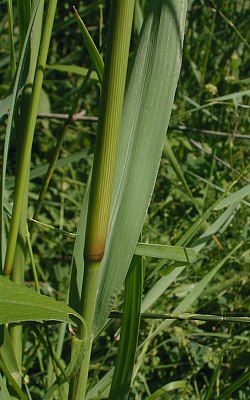
Description: This native perennial grass is 3-6' tall and more or less erect; it usually grows in large bunches. The culms are light to medium green, terete, glabrous, and fairly stout; each culm has several alternate leaves that span most of its length underneath the inflorescence. The leaf blades are up to 2/3" (15 mm.) across and 2' long; they are usually medium green (less often blue and glaucous), hairless or mostly hairless, and ascending to widely spreading. The leaf sheaths are about the same color as the blades and hairless; they are open at the mouth. Each ligule has a band of white hairs, while the nodes are swollen and often dark-colored.

The culm terminates in an inflorescence
about 8-20" long and half as much across. This inflorescence is an airy panicle
of spikelets; is broader toward the bottom than the top (pyramidal or conical).
The slender branches of the panicle are ascending to spreading and fairly
straight. Each branch terminates in a small spikelet about 4-5 mm. long that is
ellipsoid or narrowly ovoid in shape. The spikelets are initially light reddish
purple, but they later become light tan. Each spikelet has a pair of glumes, a
single fertile lemma, and a floret. The first glume is about two-thirds the
length of the spikelet, while the remaining glume and lemma are the same length
as the spikelet. The first glume gradually tapers to a long tip. The blooming
period occurs during mid-summer. Pollination of the florets is by wind. The
floret of each spikelet is replaced by a grain that is 2-3 mm. long; this grain
is ovoid-oblong in shape and somewhat flattened on one side. The root system is
fibrous and rhizomatous; the fibrous roots can penetrate more than 10 ft. in
the ground. Reproduction is by seed and vegetatively through
rhizomes.
